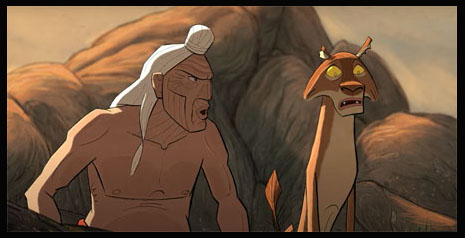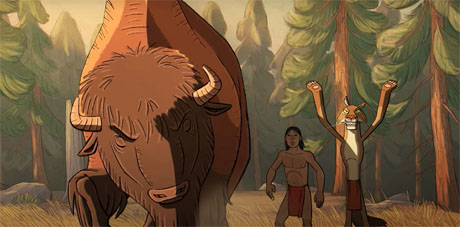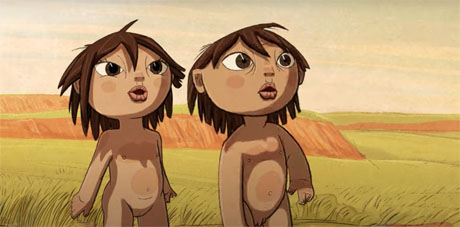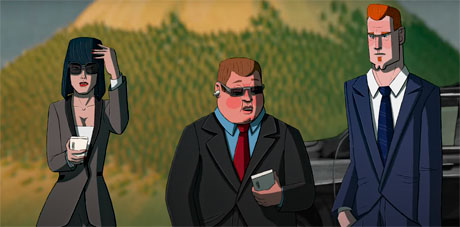
One of the 2024 Annie Awards Best Animated Feature — Independent nominees is Four Souls of Coyote. This hand-drawn film, which earned praise at the Annecy Festival last June, briefly takes place in present day, as Native Americans protest the presence of an oil pipeline construction crew on their land. The story then shifts to the beginning — to the story of Creation and how the Old Man and Coyote clash in their values and beliefs for humanity. Director Aron Gauder joins me for this Animation Scoop Q&A. (This interview was edited for length and clarity.)
Jackson Murphy: How does it feel to be an Annie Awards nominee for Best Animated Feature — Independent?
Aron Gauder: It feels good. My producer Reka [Temple] told me. I needed some time… one sleep to make it sink in. (laughs)

JM: Nice. I have to imagine that when you take on something like this, with such pacing and emotion behind it and so much going on, that it’s a journey. How do you feel that your experience making this movie has been a journey? You’ve had this in your head for a long time, right?
AG: Yeah. When I was 18, I went to a circle of people who were really into Native American stuff. That was a long time ago. Since then I’ve been really interested, and there was always an idea to make something out of it. It’s a 30-year-old story but actually we worked for eight years on it. Through patience, humbleness and stamina, it definitely changed me.
JM: I like the framework. It’s set in modern day and then we go back in time [to the beginning of Creation]. How did you want to approach that framework — history and what’s going on in the world today?
AG: Actually, it was a necessary thing to do. The Film Fund in Hungary… insisted on having a framed story. I didn’t like it in the beginning. When I was working on it — struggling with it — then [I looked at] the news and saw what was happening with the building of a pipeline. So I realized that if I have to have this framework, let’s make it real with what is happening now. Let’s start in the beginning of the Creation, and now we have to deal with it because it’s in danger. It makes the story more universal.

JM: There’s a lot of power to that. When you think about nature, has there been a personal connection… that has inspired you and stayed with you for a long time?
AG: Yes. Since I was a kid we’ve always gone into the forest camping. Now every summer I go with my kids — two weeks without gadgets. No reception in the mountains. We live in nature a lot, so most of the nature things are first-hand observations, like the river, stream and trees. I love spending time there because everything slows down and it’s a big meditation for two weeks. I love nature.
JM: There’s a lot going on with the visuals. I love the sequences — and the interactions — between Coyote and Lightning.
AG: This whole story is a fictional one, but every element of it was borrowed from different Coyote stories. There are so many of them. There’s one where Coyote steals fire… and a lightning being appears, which is really significant in Native American tradition. I had to personify it somehow. I like this character too — really abstract compared to the others.
JM: Coyote is very interesting. So much mischief. He has meat on the brain. Causing trouble… and creating man and woman. How do you dissect Coyote — showcasing the personality? There are many layers.
AG: Coyote is a little bit like Loki in the Scandinavian [mythology]. He’s the trickster there. Sometimes they both do good things. Sometimes they just follow their own instincts. For me, all these Coyote stories told me that this is our subconscious part… everybody has Coyote in him or her… greediness and wanting to devour everything. We have it inside. In the original story, it was all when Coyote makes the world. Somehow the two sides of the one person — Coyote and the Old Man.

JM: You make us think about Creation, heavenly beings and if we need them to guide us throughout our lives. How did you want to examine that aspect of this movie? The importance of a creator and… sticking with that creator throughout our lives.
AG: In this Creation story, it was more democratic, like what we know from The Bible, because the animals complain. They wanted females. They always wanted a new invention. In the original story, they wanted music and dancing. Somehow the Old Man always comes and makes them happy, but it’s not satisfying them for long. Just for a while. So they’re developing this world around them together. It’s more like teamwork. I really like that he can adjust things — it’s not ‘done’ and that these are the rules and ‘just deal with it’.
JM: I like the music a lot in your film — especially the placement of it and how you bring it in. What was challenging about that?
AG: The biggest challenge with the music was finding the artists and getting the rights. When I was doing the animatic, I was drawing and listening to music from YouTube that inspired me. It wasn’t easy to find good contemporary music. Listening helped me to find the rhythm of the movie. And I told Reka to start getting the rights. That was very difficult.

JM: You made it happen! I’m impressed with how deep this movie goes. That’s going to impact a lot of people. And you’ve already screened the film in many places around the world. How has that been — seeing audiences take this in and think about it?
AG: During the process of making the movie, I was never thinking about how they were going to receive it and what people want. That leads you aside. I was just focusing on doing it the way I want it. But when we got the first feedback from Hungary, from families and people, they really liked it and resonated with it, and that was the biggest — and best — feeling. People, one by one, after screenings talked about it. Hungarians are really resonating with it and then with the festivals, so I’m happy.
JM: You should be. And it was Hungary’s Best International Feature submission for the Academy Awards this year. Not many countries choose an animated film to be the selection. That’s a really prestigious honor.
AG: Yeah. And that was also a big risk. But I think, because of the topic, they picked our movie.
JM: How has working on this movie changed how you look at animation and the power of what animation can do for audiences?
AG: I realize that this is my favorite style — frame by frame hand animation. It’s easy to produce. When you have an idea in your head, you have a pen. You draw it. That’s the most direct way. I’ve worked with 3D and more complicated stuff, and it’s just too far away — too many steps to create the final image. So I really like it.
JM: Are you going to the Annie Awards?
AG: It seems like it. I have to organize it.
JM: Have you thought about a speech?
AG: No, and actually I’m really scared of wearing suits. I’ve never worn a suit in my life, and that’s a big challenge. (laughs) I never plan. I will try to be spontaneous.
- INTERVIEW: Strap In For “Mars Express” - April 30, 2024
- INTERVIEW: Jeff Fowler On “Knuckles” And “Sonic 3” - April 22, 2024
- INTERVIEW: “Inside Out 2” Director And Producer On Pixar Sequel - April 16, 2024


 January 19th, 2024
January 19th, 2024  Jackson Murphy
Jackson Murphy  Posted in
Posted in  Tags:
Tags: 






